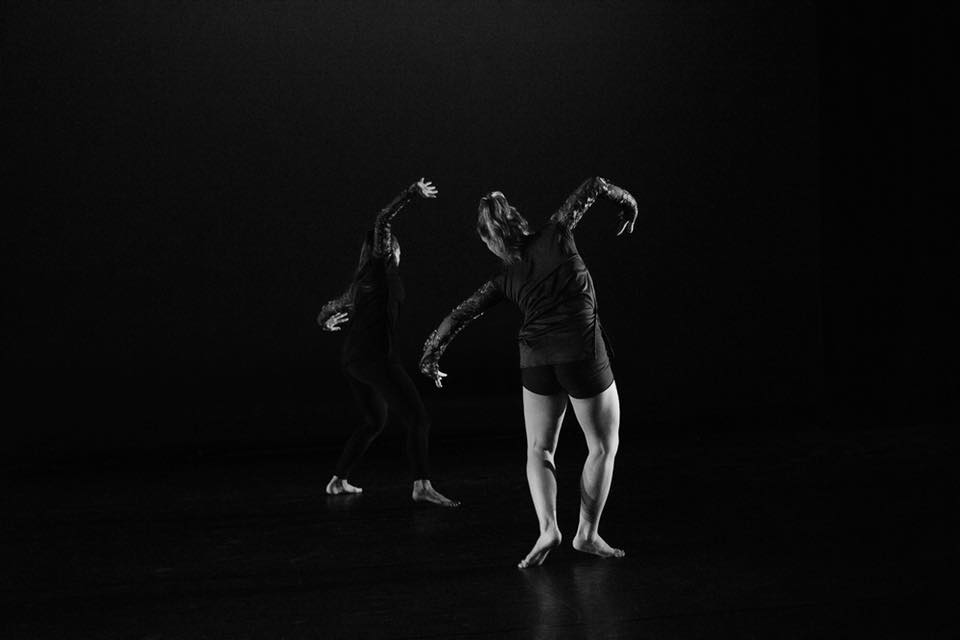This past weekend, Repertory Dance Theatre presented its fourth annual Emerge program, a collection of works choreographed by company dancers and staff. I appreciated that no unifying theme was forced on the show, so that each piece was free to be what it was.
The evening opened with “Indebted,” choreographed by RDT member Jaclyn Brown in collaboration with the performer, Angela Banchero-Kelleher. This understated piece featured gorgeous lighting and a regal yet simple feel.
“This Is What It Feels Like,” choreographed by company member Daniel Do and Mar Undag in collaboration with dancers Morgan Phillips and Nicole Smith, featured alternating solos and duets. The dancers moved with matching stylization, which was especially enjoyable to watch during a brief section of unison choreography.
Choreographed by company member Lauren Curley in collaboration with performer Mikaela Papasodero, “Soliloquy” demonstrated impressive navigation of floorwork with a full long skirt, and lovely moments of uplifted posture and gaze.
I loved the flow of overlapping parts and the contrast of fast and slow movement in the group piece “Proto,” choreographed by RDT artistic associate Nicholas Cendese and dancers. Within the group, partnering between company members Megan O’Brien and Jonathan Kim stood out to me as feeling both natural and interesting, and I appreciated that one of their sequences together was performed twice within the work with different directional orientations each time.
“I… Me… We” was a delightful piece choreographed by company member Dan Higgins, who also performed spoken word live alongside the solo danced by Morgan Phillips. The vibe was generally silly, and the movement was floppy and weird in the best way – I imagine it would be fun to perform. Through eye contact and action-reaction pairs, there was a nice connection between dancer and speaker/choreographer, as if they were trying to figure something out together but not taking it too seriously and finding amusement in the idea that they weren’t really sure of whatever it was they were exploring.
“femme.” featured beautiful and well-rehearsed partnering between dancer/choreographers Ursula Perry (of RDT) and Laja Field. I interpreted the piece to be about female friendships until a friend pointed out that the title is a word that refers to an aesthetic presentation by a lesbian that fits into society’s typical conception of a feminine look.
After a brief intermission, we saw “Trick Mirror,” choreographed by RDT dancer and education associate Megan O’Brien in collaboration with the four dancers. The part of this work that I enjoyed most was the end, the dancers lip-syncing exaggeratedly to The Bee Gees while facing the audience at the front of the stage – I’m not sure what it had to do with the rest of the piece, but it made me smile.
“Trapped” (1974) by former RDT member Lynne Wimmer was well-performed by Tiana Lovett. I loved the small, sharp movements at the beginning, Lovett’s amazing leg extensions, the grand use of space, and how Lovett seemed to break out of her trap by the end of the piece.
Comparatively, “until you are no more,” by company dancer Jonathan Kim, was much less clear in its theme. For me, the most distinct and memorable part of this piece was a simple yet effective silhouette of purposeful walking, from the downstage to upstage at the beginning of the piece, and from upstage to downstage at the end.
The program ended with “The Hours,” directed and structured by Cendese with choreography and performance by twelve dance educators. This piece got exciting during a transition where three benches, which had been stationary for the first part, were creatively moved and interacted with – I would have loved to see this section extended with more choreographic exploration of this concept. Then the benches were placed in three rows and the dancers sat facing the audience like a congregation in church pews, and from there performed a very satisfying series of movement in canon.
Within the otherwise very professional presentation, I was distracted by the amount of backstage noise throughout, including multiple instances of doors closing, cast conversations, and, once, what sounded like keys being dropped.
Overall, Emerge presented beautiful dancing alongside choreographic talent, coming together in a likeable show. I think it’s wonderful that RDT offers this opportunity for their dancers and staff to both create and share their creations.
Kendall Fischer is the artistic director of Myriad Dance Company, and has enjoyed performing opportunities with Voodoo Productions, SBDance, Municipal Ballet Co., and La Rouge Entertainment, among others. Her choreography has been performed by Myriad, Municipal Ballet, and at Creator's Grid, and her dance film project “Breathing Sky” received the 2017 Alfred Lambourne Movement prize.












